Behind this slick church conversion in the sleepy Co Limerick village of Ballyneety there lies a lifetime of labour – 27 years spent making this rural, former Church of Ireland church a place to call home.
Its owners, Des Kingston and his wife Kathleen, met at art college in Limerick and, as freshers, fell in love. Four years later they had their first child, Simon, while still students and fresh out of college. Having set up a signwriting business, graphics graduate Des was working with a number of clients including architect Michael Healy of Healy & Partners Kingston.
Cahernorry Church was up for sale. It had originally been built at a location four miles away and in 1862 was moved, lock, stock and altar to its current resting place, on the outskirts of Ballyneety. Apparently its congregation, the local gentry, had found its first resting place too far away.
0 of 3
Des knew the Gothic limestone church. It was a sad, lonely looking place, he recalls, and he asked Healy for his advice on its conversion. It turned out that Healy had worked with another potential buyer on ideas on how to convert the building and produced a set of schematics from a drawer.
Healy gave him great advice including who he needed to write to make an offer to buy it. “We didn’t have a penny, barely a business,” he recalls. “We’d no clue what it was going to cost.”
This was 1989 and the property was asking IR£9,000 punts (about €11,427). While the couple fell in love with it the day they went to view it, it took two years for the sale to go through.
In that 24-month period they spent their time imagining, planning and designing what it might look like. They even started buying pieces they felt might work in the property including an altar from a church in Kathleen's home place, Truagh, Co Clare, a village that is about a five-minute drive from Ardnacrusha, and a Georgian fireplace given to them by a friend.
Des's father, Jack Kingston, now deceased, had been an auctioneer in Tipperary town and also contributed some furniture and lighting.
Repairs
The property was devoid of either pews or an altar and was missing most of the glass from its leaded windows. They managed to borrow a total of IRE30,000 (about €38,092) and with the remaining monies repaired leaks in the roof, installed electricity and plumbing and some walls and doors for bedrooms. “There was no kitchen. It was very basic and every penny we’ve made since has gone into the place. The look and feel was arts and crafts but the family all lived in jumpers, even inside. It wasn’t a warm house,” Des admits.
But then about a decade ago the property had what you might like to call its second coming. They had more access to money and decided to redesign the whole interior gutting the home so completely that the family moved out for two years while Des and a select few friends tore it all asunder.
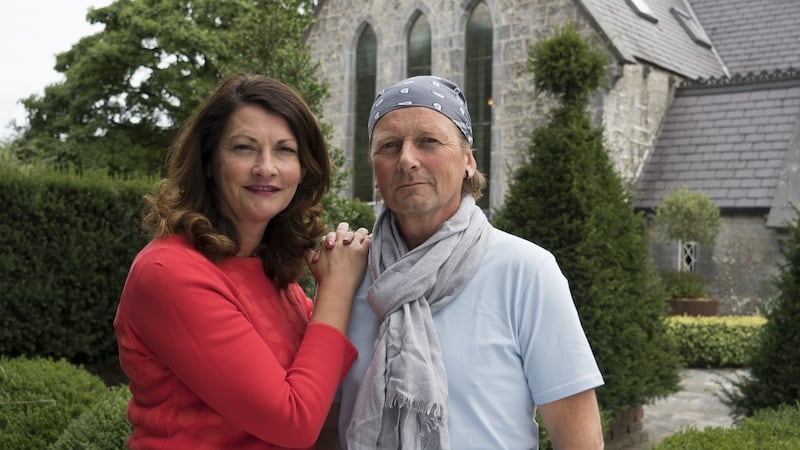
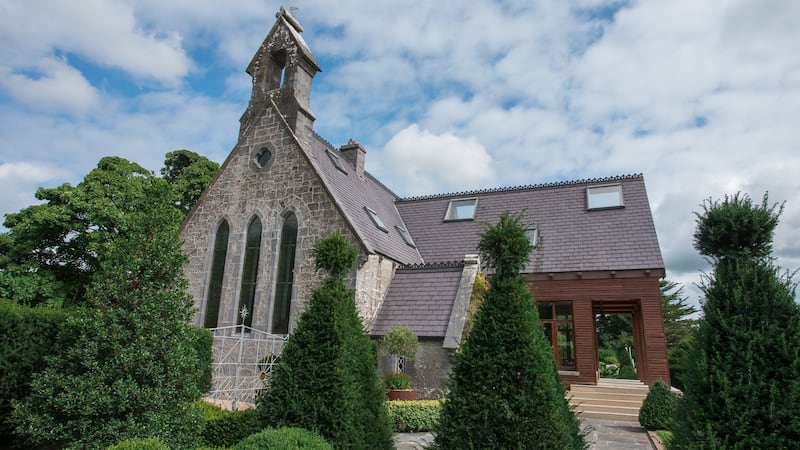
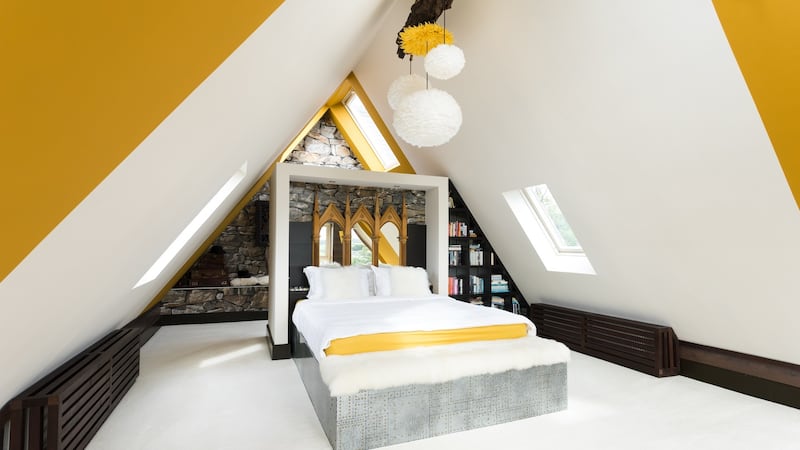
The render on the interior was in such bad condition that they decided to remove it all exposing the original stone walls and the red brick window surrounds.
Using plans drafted by Healy, they added a cedar-clad extension to the front, installing a porch and sunroom at entry level and breaking through the original stone wall to create a new front entrance. The original vestibule became Des’s home office. From the sunroom a Gothic arched door takes you through to the living room where steps on either side of the fireplace, set into a vertical half-wall, lead up to the dining room. Two tropical hardwood trunks flank this entrance. These were salvaged from a skip outside Brown Thomas, Limerick.
Proper insulation
This time round it has been properly insulated and the underfloor heating means the family can relegate sweaters to outdoor excursions. It is now so snug that the family can pad about in their stockinged feet.
As well as feeling much warmer it is also brighter, thanks to the use of a travertine tile underfoot. It also graces the dividing wall between the living and dining rooms and has been laid out in a staggered fashion to emulate blocks of stone.
An L-shaped sofa is set around the Georgian fireplace, the one they owned before they ever bought the church. Here the crosshatched ceiling has been fabricated from a laminate flooring and a variation on the same ceiling has been carried through to the living room.
This is a room that has stories to tell. Neither Des nor Kathleen is ever lost for words at a dinner party here. They simply start recounting the origins of the furnishings. The built-in nooks are backed in mirror and each is individually lit by a spotlight. There is coffered strip lighting overhead and the glass-topped table is set on a plinth that was inspired by an old stone vault and has been clad in the same treated zinc as the above-counter units in the kitchen. Etched into its pedestal top is a psalm that a monk at Glenstal Abbey suggested to Des when he cold called him to ask for advice – he wanted a psalm but one that was appropriate to a family living in a church.
And if you still find a lull in the conversation, you can refer guests to the suite of antique coffin handles that Des sourced from a local undertaker that also decorate the plinth. Repurposed pews sit around the table and there is a steampunk-style drinks cabinet, complete with gold leaf covered mannequin’s hand that acts as a drawer handle. Its interior is lined in old deeds and official letters from his father’s former auctioneering business.
Worshipping the cook
The kitchen is now a space where any cook can worship. Set into the space where the altar would have been, it is framed by three huge Gothic windows. The large U-shaped design is washed in light from the fenestration, each pane of its coloured glass painstakingly cut and installed by hand by Des, using an ecclesiastical colour palette of Advent purple and Galero green in the upper panes. They brought the glass from France and it took him a whole winter to remove the original putty from each pane and cut each piece to size, install it with putty and repeat. It was, he says, "an absolute jigsaw", and took him a whole winter up a ladder in the freezing cold.
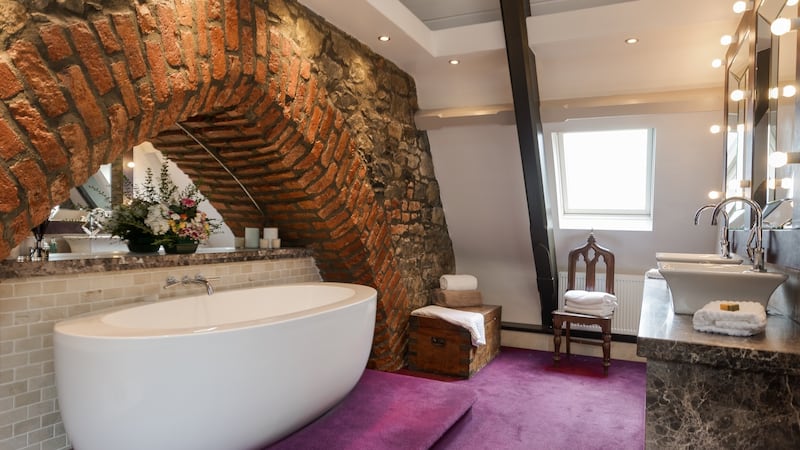
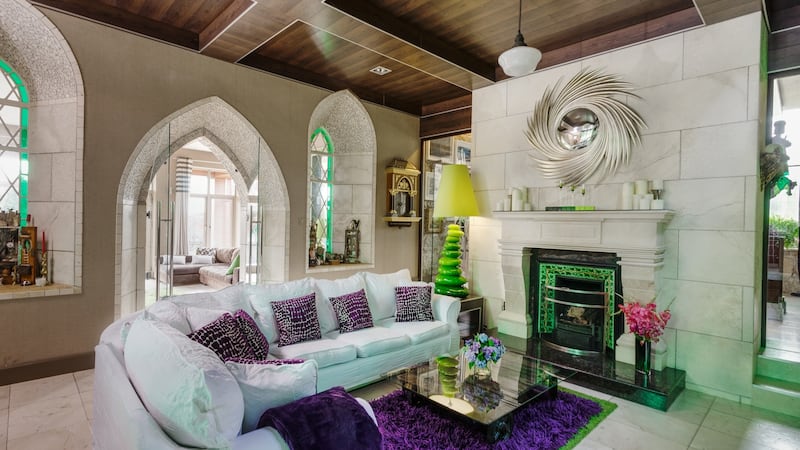
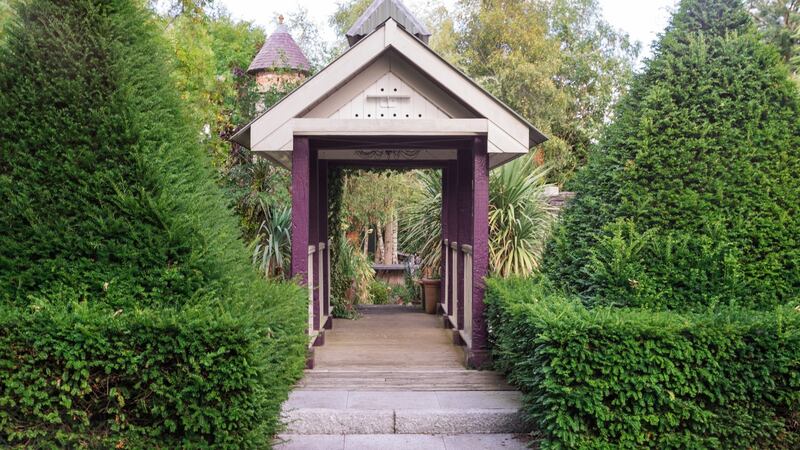
There is counter space aplenty and above it the units have been clad in a zinc that has been chemically treated to give it its aged effect. The sacristy is now their utility room.
In the window recesses of the main body of the church sit sculptures made by Des. In one, a fashion mannequin sports a deer skull and antlers as well as curios given to Des by his father. It’s a life-like cabinet of curiosities that includes roman coins and his kids’ baby teeth.
Upstairs there are three bedrooms. The master is a steeple-shaped room that has been painted a strong mustard colour. The top of the altar they had bought years ago has been repurposed here as a bed head. The gable wall is completely glazed and the couple can enjoy the glorious countryside from their bed.
The rest of the altar forms the base of the vanity unit in the family bathroom where a free-standing bath is set under a brick arch.
The church now stands on an acre of grounds. Laid out as a formal garden, the kind the local gentry might have had, Des, whose green fingers garnered him first prize in the 2017 RTÉ's Supergarden series, which also showcased at Bloom that year, has clipped topiary yews into shapes that resemble a bishop's mitre. He is available for commissions and opens the garden to groups.
Parked in front is a 1946 Cadillac Fleetwood that he bought on Done Deal and is his next project. He plans to repurpose the vehicle into a variety of artworks.
You can watch the house on the upcoming series of Home of the Year, which launches on Tuesday, February, 19th at 8.30pm on RTÉ 1.
deskingstondesign.com; healypartners.com; rte.ie
Share your home story
Have you recently extended or renovated your home? Or built a new house from scratch? We'd love to hear how you got on. Please email homeanddesign@irishtimes.com















